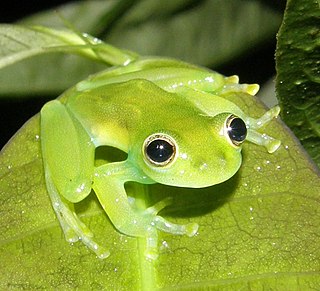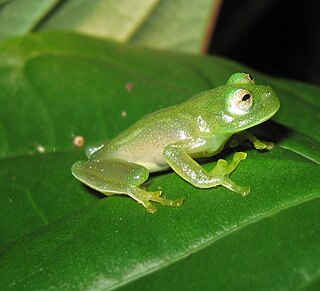 W
WThe glass frogs are frogs of the amphibian family Centrolenidae. While the general background coloration of most glass frogs is primarily lime green, the abdominal skin of some members of this family is transparent and translucent. The internal viscera, including the heart, liver, and gastrointestinal tract, are visible through the skin, hence the common name is given as glass frog. Glass frogs are arboreal, meaning they mainly live in trees, and only come out for mating season.
 W
WHyalinobatrachinae is a subfamily of glass frogs that was established in 2009. They are found in the Americas from Mexico south to southeastern Brazil and Argentina.
 W
WCentrolene is a genus of glass frogs in the family Centrolenidae. The adult males are characterized by having a humeral spine, as most members of this family. The delimitation of this genus versus Cochranella is not fully resolved, and some species formerly in Centrolenella — which is nowadays synonymized with Centrolene — are now in Hyalinobatrachium.
 W
WThe glass frogs are frogs of the amphibian family Centrolenidae. While the general background coloration of most glass frogs is primarily lime green, the abdominal skin of some members of this family is transparent and translucent. The internal viscera, including the heart, liver, and gastrointestinal tract, are visible through the skin, hence the common name is given as glass frog. Glass frogs are arboreal, meaning they mainly live in trees, and only come out for mating season.
 W
WCentroleninae is one of two subfamilies of the family Centrolenidae. It has nine genera distributed in Central America from Honduras south and east to northern and central South America. As of mid 2015, it contains 117 species.
 W
WChimerella is a small genus of glass frogs, family Centrolenidae. They are found on the Amazonian slopes of the Andes in Ecuador and Peru, possibly extending into Colombia.
 W
WCochranella is a genus of glass frogs, family Centrolenidae. They are found in Central America from Honduras southward to the Amazonian and Andean cloud forests of Colombia, Ecuador, Peru, and Bolivia.
 W
WEspadarana is a genus of glass frogs. They are found in Central America and northern South America.
 W
WHyalinobatrachium is a genus of glass frogs, family Centrolenidae. They are widely distributed in the Americas, from tropical Mexico to southeastern Brazil and Argentina.
 W
WIkakogi is a genus of frogs in the family Centrolenidae. It has been tentatively placed in the subfamily Centroleninae, although more recent analyses suggest that it is the sister group of the clade Centroleninae+Hyalinobatrachiinae.
 W
WIkakogi tayrona, or the Magdalena giant glass frog, is a species of frog in the family Centrolenidae. It is endemic to the Sierra Nevada de Santa Marta, Magdalena Department, Colombia. It is the only glass frog that is known to show maternal care.
 W
WNymphargus is a genus of glass frogs in the subfamily Centroleninae, which was established in 2007. They are distributed in the Andean slopes of Colombia, Ecuador, Peru, and Bolivia. They are characterized by lacking webbing among the outer fingers, lacking humeral spines in adult males, and having a lobed liver covered by a transparent hepatic peritoneum.
 W
WRulyrana is a small genus of glass frogs. They are found in South America, on the Amazonian slopes of the Andes in Ecuador, Peru, and possibly Bolivia, as well as on the eastern slopes of the Cordillera Central and the western slopes of the Cordillera Oriental in Colombia.
 W
WSachatamia is a small genus of glass frogs. They are found in Central America and northern South America at altitudes below 1,500 m (4,900 ft) above sea level.
 W
WTeratohyla is a small genus of glassfrogs in the subfamily Centroleninae. The genus was for a while included in Centrolenella and then Cochranella, but it was resurrected in 2009. These frogs are distributed from lowlands of Central America from Honduras southwards to Pacific and Amazonian wet tropical lowlands of South America.
 W
WVitreorana is a genus of glass frogs that are native to South America, from the Atlantic Forest of Brazil and Argentina to the Amazon rainforest of Colombia and Ecuador and to the Venezuelan Coastal Range and the Guianas.